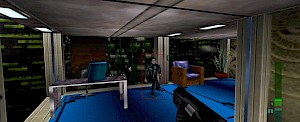News: Nintendo DS Factsheet

Posted 21 Sep 2004 at 11:11 by guest
Nintendo threw in a new factsheet, with a few minor changes compared to the previous (E3) factsheet.

Nintendo's latest innovation, code-named Nintendo DS, provides users with a unique game-play experience using features never before offered by any other home console or hand-held game system. This portable personal entertainment and communications unit provides owners with new perspectives on dual screens, new control using both touch and voice, and new connections with two kinds of wireless game play. It's a newfound canvas on which developers can express their creativity.Dual Screens: Two LCD screens offer one of the most groundbreaking game-play advances ever developed: experiencing a game from two perspectives at once. Imagine the possibilities. In a racing game, drivers might see their own vehicle's perspective on one screen and an overall track view on the other. In a role-playing game, the action could take place on the first screen while the second provides a reference for a player's tools inventory. Game play also could use both screens at once, offering a giant boss for heroes to defeat. In the future, games could be created allowing users to play games on one screen while text messaging other DS users on the other. Each 3-inch screen can reproduce a true 3-D view and is backlit to assure comfortable play in any lighting condition.
Touch Screen: The lower screen will offer something never before provided by any game device: PDA-like touch capabilities. Players no longer have to rely on just buttons to move characters or shift perspectives. They can navigate menus or access inventory items simply by touching the screen with stylus or fingertip. A software-based keyboard might even allow the screen to be used as an input center for games and messaging. The possibilities are limited only by developers' imaginations. The screen will have a tougher film cover for durability, and will come with a stylus.
Microphone: An available microphone port means that in the future, players might need only to tell their games what to do. DS software could identify everything from voice commands to hand-clapping. Players might be able to move their characters simply by telling them which way to go. The voice capabilities also could allow gamers to chat with one another over the Internet while playing.
Input/Output: Ports for both Nintendo DS Game Cards and Game Boy� Advance Game Paks, terminals for stereo headphones and microphone
Wireless: DS users will be able to connect with a local wireless network of up to 16 players. Nintendo's guaranteed range is 30 feet, but will extend far beyond that depending on circumstances (30 to 100 feet). It assures high response rates required for real time game play, and will make use of both IEEE 802.11 and Nintendo's proprietary communication protocol, which provides low battery consumption. Players will be able to chat and play games without any connecting cords, completely untethered. The DS technology also provides for a wireless LAN connection, which could allow a theoretically infinite number of players to connect at a hot spot and compete at a central game hub on the Internet, even if they're thousands of miles apart.
Wireless Game Sharing: If software developers desire, multiple players can compete in wireless games, even if only one person has a game card inserted. Players could also test-play games for themselves as long as they stayed connected.
3-D: With the newly developed graphics engine, DS can reproduce impressive 3-D renderings that can surpass images displayed on the Nintendo� 64. Games will run at 60 frames per second, and allow details like fog effects and cel shading.
Sound: The 16-channel sound allows for greatly expanded use of voices and music, and a richer, more immersive game experience. Stereo speakers providing virtual surround sound, depending on the software. A plug for headphones transmits stereo sound.
Battery & Power Management: The battery is rechargeable and the unit features a low-energy-consumption design. The DS also has Power Management functions of Sleep mode and Standby mode. In Sleep mode, players can stop and resume game play whenever they like. If the user receives a message from a friend or user nearby, DS activates itself from Standby mode. Lithium ion battery delivering six to 10 hours of play on a four-hour charge, depending on use; power-saving sleep mode; AC adapter.
Processing: The unit will run on two processors, one ARM9 one ARM7.
New Media: For its compact cards, the unit uses newly developed semiconductor memory, which allows for lower cost, shorter manufacturing time and memory capacity of more than one gigabit of information.
Dual Slots: Nintendo DS makes a vast library of Game Boy� Advance games readily available. Developers could find ways to make new connections between GBA games and DS games. The GBA port could be used for new hardware, enormously expanding the functional expandability of the DS.
Other Features: Embedded PictoChat software that allows up to 16 users to chat at once, embedded real-time clock, date, time and alarm, touch-screen calibration
Languages: English, Japanese, Spanish, French, German, Italian
Color: Silver and black
Ok, so WHERE do we have to look at exactly? First of all, there's this quote from the Micorphone section: "The voice capabilities also could allow gamers to chat with one another over the Internet while playing". Internet-play? Even though Reggie spoke about playing a distant friend, Nintendo never officially confirmed the Nintendo DS being capable of hooking up to a wireless hub and thus access the Internet. This theory is strenghtened by the next quote (from the Wireless section): "The DS technology also provides for a wireless LAN connection, which could allow a theoretically infinite number of players to connect at a hot spot and compete at a central game hub on the Internet, even if they're thousands of miles apart".
Next up: "terminals for stereo headphones and microphone" (Input/Output). After we revealed the so-called 'secret port' in the Nintendo DS unit to be a headset connector, Nintendo didn't speak about the connector anymore. This time, Nintendo officially confirms the port to be that which we expected it to be.
On to the more important details: GRAPHICS! "Games will run at 60 frames per second, and allow details like fog effects and cel shading". Is that 60-frames-per-second with fog effects and cell shading effects?! Now this will allow some serious graphics.
But we're still not there. Nintendo has hidden quite a few new features in this list. People were wondering about the battery. Nintendo claims the NDS will be able to run on the lithium-ion battery for six to 10 hours (after a four hour charge). That's about the same time a GBA SP will live with its light enabled. No problems here either...
Next on the list is the mentioning of the GBA port: "The GBA port could be used for new hardware, enormously expanding the functional expandability of the DS". Last week, several rumours were already spreading about the GBA port being used for NDS pheripherals, but now we've got it confirmed.
Then the embedded options: PictoChat, a real-time clock, date, time, alarm and touch-screen calibration. I think we can start calling the NDS a (mini-)PDA. Maybe we can even start synchronizing our clock using the wireless LAN connections, but then again this might be a little bit far-fetched.
Now we've got a little bit of a problem. The factsheet reads "Languages: English, Japanese, Spanish, French, German, Italian". Languages?! The Nintendo DS probably contains some kind of hardware configuration-screen which allows us to set the clock and calibrate the touchscreen.
And finally, the last line of the factsheet. Nintendo starts talking about the available colors of the NDS unit: Silver and Black. Whether Nintendo is pointing at two different color schemes for the Nintendo DS units at launch, or simple the colors of which the current design consists of. We hope the first...





















